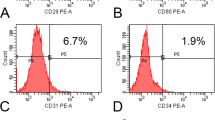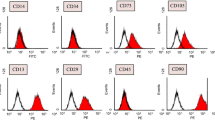Abstract
Introduction
Bone marrow mesenchymal stem cells (MSCs) are ideal target cells for cell transplantation and tissue engineering. We investigated their biological characteristics and differentiation mediated by different methods. It is important to study the short-term fate of labeled allogeneic MSCs after subcutaneous implantation in rabbits in order to provide insights into the application of allogeneic MSCs for tissue regeneration.
Materials and methods
Mesenchymal stem cells were labeled by two different methods in vitro and then were incubated with gelatin sponge. Autologous MSCs-Gelatin constructs and allogeneic MSCs-Gelatin constructs were subcutaneously implanted into 32 rabbits. The constructs were analyzed for the survival and migration of labeled MSCs at day 3, week 1, 3, and 5 post-implantation.
Results
EGFP was successfully expressed following transfection of MSCs with the retroviral vector pLEGFP-N1. In addition, EGFP-MSCs can be functionally induced into osteocytes, chondrocytes, and adipocytes in conditioned media. By weeks 3 after implantation, the labeled cells distributed extensively on the surface of gelatin sponge and gradually integrated into host tissues. EGFP-labeled MSCs were observed under fluorescence microscopy and BrdU-expressing cells were detected with immunohistochemical stain in allogeneic or autologous MSCs-Gelatin constructs during the initial five weeks after implantation.
Conclusions
It is a simple and reliable way to trace the changes of MSCs in vivo by EGFP in cell transplantation and gene therapy. Allogeneic rabbit MSCs can survive for at least 5 weeks after subcutaneous implantation and maintain a strong ability of migration, indicating that allogeneic MSCs are of certain value in clinical application for temporary replacement.







Similar content being viewed by others
Reference
Awad HA, Butler DL, Boivin GP, Smith FN, Malaviya P, Huibregtse B, Caplan AI (1999) Autologous mesenchymal stem cell-mediated repair of tendon. Tissue Eng 5:267–277
Bartholomew A, Sturgeon C, Siatskas M, Ferrer K, McIntosh K, Patil S, Hardy W, Devine S, Ucker D, Deans R, Moseley A, Hoffman R (2002) Mesenchymal stem cells suppress lymphocyte proliferation in vitro and prolong skin graft survival in vivo. Exp Hematol 30:42–48
Campagnoli C, Roberts IA, Kumar S, Bennett PR, Bellantuono I, Fisk NM (2001) Identification of mesenchymal stem/progenitor cells in human first-trimester fetal blood, liver, and bone marrow. Blood 98:2396–2402
Chalfie M, Tu Y, Euskirchen G, Ward WW, Prasher DC (1994) Green fluorescent protein as a marker for gene expression. Science 263:802–805
Deans RJ, Moseley AB (2000) Mesenchymal stem cells Biology and potential clinical uses. Exp Hematol 28(8):875–884
Delorme B, Charbord P (2007) Culture and characterization of human bone marrow mesenchymal stem cells. Methods Mol Med 140:67–81
Deng W, Han Q, Liao L, Li C, Ge W, Zhao Z, You S, Deng H, Murad F, Zhao RC (2005) Engrafted bone marrow-derived flk-(1+) mesenchymal stem cells regenerate skin tissue. Tissue Eng 11:110–119
Duan XJ, Yang L, Zhou Y, Tang KL, Wang DW (2005) Influence of fluorescent protein expression on the proliferation of NIH3T3 cells in vitro. Zhonghua Shao Shang Za Zhi 21:374–377
Duan X, Yang L, Zhou Y, Xin Y, Li Q (2006) Application of enhanced green fluorescent protein labeling technology to monitoring marrow mesenchymal stem cells migration after bone fracture. Zhongguo Xiu Fu Chong Jian Wai Ke Za Zhi 20:102–106
Eve DJ, Sanberg PR (2007) Stem cell research in Cell Transplantation: an analysis of geopolitical influence by publications. Cell Transplant 16(8):867–873
Fang Y, Huang CC, Kain SR, Li X (1999) Use of coexpressed enhanced green fluorescent protein as a marker for identifying transfected cells. Methods Enzymol 302:207–212
Fathke C, Wilson L, Hutter J, Kapoor V, Smith A, Hocking A, Isik F (2004) Contribution of bone marrow-derived cells to skin: collagen deposition and wound repair. Stem Cells 22:812–822
Friedenstein AJ (1976) Precursor cells of mechanocytes. Int Rev Cytol 47:327–359
Fu X, Fang L, Li X, Cheng B, Sheng Z (2006) Enhanced wound-healing quality with bone marrow mesenchymal stem cells autografting after skin injury. Wound Repair Regen 14:325–335
Gimble JM, Robinson CE, Wu X, Kelly KA, Rodriguez BR, Kliewer SA, Lehmann JM, Morris DC (1996) Peroxisome proliferator-activated receptor-gamma activation by thiazolidinediones induces adipogenesis in bone marrow stromal cells. Mol Pharmacol 50:1087–1094
Horwitz EM, Prockop DJ, Fitzpatrick LA, Koo WW, Gordon PL, Neel M, Sussman M, Orchard P, Marx JC, Pyeritz RE, Brenner MK (1999) Transplantability and therapeutic effects of bone marrow-derived mesenchymal cells in children with osteogenesis imperfecta. Nat Med 5(3):309–313
Jensen UB, Lowell S, Watt FM (1999) The spatial relationship between stem cells and their progeny in the basal layer of human epidermis: a new view based on whole-mount labelling and lineage analysis. Development 126(11):2409–2418
Jiang Y, Jahagirdar BN, Reinhardt RL, Schwartz RE, Keene CD, Ortiz-Gonzalez XR, Reyes M, Lenvik T, Lund T, Blackstad M, Du J, Aldrich S, Lisberg A, Low WC, Largaespada DA, Verfaillie CM (2002) Pluripotent nature of adult marrow derived mesenchymal stem cells. Nature 418:41–49
Johnstone B, Hering TM, Caplan AI, Goldberg VM, Yoo JU (1998) In vitro chondrogenesis of bone marrow-derived mesenchymal progenitor cells. Exp Cell Res 238:265–272
Kadiyala S, Young RG, Thiede MA, Bruder SP (1997) Culture-expanded canine mesenchymal stem cells possess osteochondrogenic potential in vivo and in vitro. Cell Transplant 6:125–134
Krause DS (2002) Plasticity of marrow-derived stem cells. Gene Ther 9(11):754–758
Lapidot-Lifson Y, Lebo RV, Flandermeyer RR, Chung JH, Golbus MS (1996) Rapid aneuploid diagnosis of high-risk fetuses by fluorescence in situ hybridization. Am J Obstet Gynecol 174:886–890
Le Blanc K, Ringden O (2006) Mesenchymal stem cells: properties and role in clinical bone marrow transplantation. Curr Opin Immunol 18:586–591
Liechty KW, Shaaban AF (2000) Human mesenchymal stem cells engraft and demonstrate site-specific differentiation after in utero transplantation in sheep. Nat Med 6:1282–1286
Majumdar MK, Thiede MA, Mosca JD, Moorman M, Gerson SL (1998) Phenotypic and functional comparison of cultures of marrow-derived mesenchymal stem cells (MSCs) and stromal cells. J Cell Physiol 176:57–66
Mezey E, Chandross KJ, Harta G, Maki RA, McKercher SR (2000) Turning blood into brain: cells bearing neuronal antigens generated in vivo from bone marrow. Science 290:1672–1674
Nauta AJ, Kruisselbrink AB, Lurvink E, Willemze R, Fibbe WE (2006) Mesenchymal stem cells inhibit generation and function of both CD34+-derived and monocyte-derived dendritic cells. J Immunol 177:2080–2087
Panchal RG, Williams DA, Kitchener PD, Reilly AM, Khan J, Bowser DN, Petrou S (2001) Gene transfer: manipulating and monitoring function in cells and tissues. Clin Exp Pharmacol Physiol 28:687–691
Pittenger MF, Mackay AM, Beck SC, Jaiswal RK, Douglas R, Mosca JD, Moorman MA, Simonetti DW, Craig S, Marshak DR (1999) Multilineage potential of adult human mesenchymal stem cells. Science 284:143–147
Pommey S, Galipeau J (2006) The use of mesenchymal stromal cells in oncology and cell therapy. Bull Cancer 93:901–907
Quarto R, Mastrogiacomo M, Cancedda R, Kutepov SM, Mukhachev V, Lavroukov A, Kon E, Marcacci M (2001) Repair of large bone defects with the use of autologous bone marrow stromal cells. N Engl J Med 344(5):385–386
Quintavalla J, Uziel-Fusi S, Yin J, Boehnlein E, Pastor G, Blancuzzi V, Singh HN, Kraus KH, O’Byrne E, Pellas TC (2002) Fluorescently labeled mesenchymal stem cells (MSCs) maintain multilineage potential and can be detected following implantation into articular cartilage defects. Biomaterials 23:109–119
Ringden O, Uzunel M, Rasmusson I, Remberger M, Sundberg B, Lonnies H, Marschall HU, Dlugosz A, Szakos A, Hassan Z, Omazic B, Aschan J, Barkholt L, Le Blanc K (2006) Mesenchymal stem cells for treatment of therapy-resistant graft-versus-host disease. Transplantation 81:1390–1397
Satoh H, Kishi K, Tanaka T, Kubota Y, Nakajima T, Akasaka Y, Ishii T (2004) Transplanted mesenchymal stem cells are effective for skin regeneration in acute cutaneous wounds. Cell Transplant 13:405–412
Sechrist J, Coulombe JN, Bronner-Fraser M (1989) Combined vital dye labelling and catecholamine histofluorescence of transplanted ciliary ganglion cells. J Neural Transplant 1:113–128
Sottile V, Halleux C, Bassilana F, Keller H, Seuwen K (2002) Stem cell characteristics of human trabecular bone-derived cells. Bone 30:699–704
Wakitani S, Imoto K, Yamamoto T, Saito M, Murata N, Yoneda M (2002) Human autologous culture expanded bone marrow mesenchymal cell transplantation for repair of cartilage defects in osteoarthritic knees. Osteoarthr Cartil 10:199–206
Wu M, Yang L, Liu S, Li H, Hui N, Wang F, Liu H (2006) Differentiation potential of human embryonic mesenchymal stem cells for skin-related tissue. Br J Dermatol 155:282–291
Zuk PA, Zhu M, Mizuno H, Huang J, Futrell JW, Katz AJ, Benhaim P, Lorenz HP, Hedrick MH (2001) Multilineage cells from human adipose tissue: implications for cell-based therapies. Tissue Eng 7:211–228
Acknowledgments
This work was financially supported by the National Natural Science Foundation of China (Grant No. 30300079 and No.30400100) and Key Medical Research Projects of PLA (Grant No. 06G079). The authors thank the staff of the State Key Laboratory of Trauma, Burns and Combined Injury, Institute of Combined Injury, The Third Military Medical University for supplying experimental equipment. They also thank Prof. Z. Zou. of our university for critical review of this manuscript.
Author information
Authors and Affiliations
Corresponding author
Rights and permissions
About this article
Cite this article
Duan, X., Yang, L., Dong, S. et al. Characterization of EGFP-labeled mesenchymal stem cells and redistribution of allogeneic cells after subcutaneous implantation. Arch Orthop Trauma Surg 128, 751–759 (2008). https://doi.org/10.1007/s00402-008-0585-y
Received:
Published:
Issue Date:
DOI: https://doi.org/10.1007/s00402-008-0585-y




